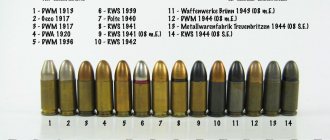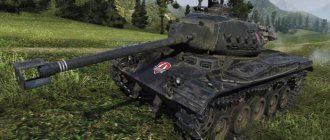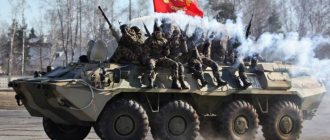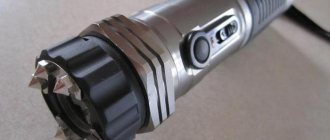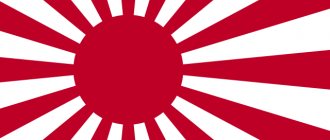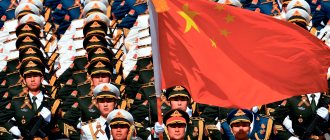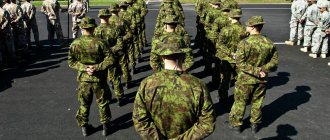The military art of any state is filled with specific traditions that have been formed over centuries. Many countries in world history were famous for their ability to wage war beautifully, but only a few of them have preserved ancient customs in our time. As practice shows, such states are the most combat-ready, because war is an innate instinct for their soldiers. Such states include Switzerland, famous for its mercenaries, Germany, which twice waged war against the whole world, Great Britain with its best sailors, as well as Spain, whose infantry is known throughout the world. But in world history there is another country whose army is no worse than those listed above. This state has repeatedly waged war with China, Russia, and also played an important role in World War II. Thus, the article will discuss the structure, size, history and other features of the army of the state of Japan.
The Imperial Army is the source of modern Japanese armed forces
The modern army of Japan is a historical echo of a once-existing army, which was known throughout the world for its mercilessness, strength and power. However, the creation of the Japanese army was preceded by a series of reforms. Initially, there was no single military formation in Japan.
The basis of the country's defense were specific samurai militias, which were practically uncontrollable. But by 1871, the Imperial Japanese Army appeared in the country. The basis of the military formation was the individual troops of several principalities (Choshu, Tosa, Satsuma). The main regulatory agencies were the Department of the Army and Navy. Within a few years, the imperial army became a formidable force, which repeatedly proved its power in battles with the Russian Empire, China and the British colonies. However, the history of the Imperial Japanese Army was sealed when the country entered into an alliance with Nazi Germany and Fascist Italy.
***
Even in conditions where the army is prohibited by the constitution, Japan makes the most of the restrictions and strengthens its defense capabilities. And Donald Trump’s unpredictability in relations with long-time partners and the growing threat from the DPRK and China are encouraging the Japanese to increasingly rely on themselves and improve relations with other countries.
As a result, even if Trump wins the election again and continues to be skeptical about protecting allies, Tokyo will quietly develop its alliance with other regional powers that fear Chinese power.
The paradox is that if Japan actually leaves the influence of the Americans, the situation in the Asia-Pacific region will most likely only worsen. Here, nuclear North Korea, the USA and China are already habitually flexing their muscles - and another independent and powerful player will be more likely to provoke a military conflict. Arguments of a different caliber could significantly aggravate relations with Russia on the issue of the Kuril Islands - after all, a peace treaty has not yet been signed between the countries. But, fortunately, this scenario is still very far from being realized.
Creation of self-defense
In 1945, Japan was defeated in World War II. The occupation forces of the United States of America liquidated the imperial army, and by mid-1947, absolutely all military educational institutions were closed, and traditional martial arts were prohibited. From this moment on, the state of Japan is under complete control of the United States.
Already in 1951, the American authorities received permission to place their military bases on Japanese territory. After this, the state gradually began to develop its own armed forces, which operated solely on the basis of the principle of state defense. Thus, self-defense forces appear in Japan. By the beginning of the 21st century, these forces had turned into a professional military formation deserving the status of the armed forces. At the same time, the ban on the use of Japanese armed forces outside the territory of the state is lifted. Today, Japan's self-defense is a professional army with its own structure and a clear list of tasks. The army size is 247 thousand people.
▍ Unbridled militaristic propaganda.
The fears turned out to be not entirely unfounded.
Of course, there is little that compares with the ocean of Russian victims of Stalin and Nicholas II, but the theme of falling in love is also popular in Japan. Takumi Yanai spent many years serving in the Self-Defense Forces, and then became the author of hit novels and the manga “The Gate: Where Our Warriors Fight.” The transition to civilian life did not allow him: in the pages of Yanai, brave Japanese fighters are sent into the world of classic fantasy, where they inflict democracy and human rights through superior firepower. What could be better against a horde of orcs than volleys of MLRS? Why not solve the problem of dragons with air-to-air missiles, and save the oppressed elves by landing special forces with the support of attack helicopters under Wagner with a direct quote from Apocalypse Now?
The film adaptation of The Gate as an anime series in 2015 was directly and openly accompanied by a massive propaganda campaign by the Self-Defense Forces. All of Japan was covered in posters and banners with Gate characters and calls to wear military uniform and protect someone. Moreover, “coincidentally” it was at this time that Abe’s cabinet was promoting in parliament a bill to authorize the use of the Self-Defense Forces for operations abroad. The popularity of anime about brave men crushing orcs with tanks and saving elves from feudal chauvinists largely helped the military and government turn the situation in their favor and pass the bill, despite mass protests and resistance from pacifists.
Well, when asked directly by the press, officials put on poker faces and claimed that anime and the bill were a complete coincidence.
The Self-Defense Forces no longer tried to allow such overt militaristic propaganda; in addition to obvious success, there was also strong negative hype - but by now anime had penetrated the Japanese military department with the omnipresence of tentacles. Almost all departments and divisions have acquired anime mascots, and although the peak popularity of near-war anime remained in the mid-1990s, every now and then one or another current title mysteriously ends up on the propaganda materials of military registration and enlistment offices. After all, Chinese military power is growing stronger, the prospect of a new war in the “South Seas” is growing, and more and more young people need to be recruited to serve in the increasingly ambitious and high-tech Self-Defense Forces. For example, in the revived a couple of years ago for the first time since the Second World Marine Corps. Well, there’s not a lot of money, you have to hold on, so instead of high salaries for the military - which all the pacifists in parliament and the liberal media will immediately oppose - it’s easier to draw a few more anime girls on propaganda posters.
What’s funny is that the experiment was also appreciated at the Pentagon. More recently, in May 2022, the US Army launched a series of propaganda videos on YouTube with animated characters - although, unlike the Japanese ones, they were emphatically diverse. The cycle "The Calling", that is, "Call", describes the fate of five soldiers of the American army. Immigrant Ricky from Haiti and the daughter of immigrants from the Dominican Republic, Japanese Toguchi from Hawaii, white Californian Emma, raised in a same-sex family, singer Janine from a black military dynasty are encouraged to join the US Army - and, um, save and help people around the globe.
So it goes.
PS
My first article on this topic was published elsewhere, a year ago, and some of the events around individual episodes are described there in more detail.
Operating principles
The Japanese armed forces operate on the basis of principles that incorporate many moral standards and political doctrines. There are only four basic principles:
1. Refusal to attack. This means that the state will not use its troops to directly attack or violate the territorial integrity of other states.
2. Refusal to use nuclear weapons.
3. Widespread continuous monitoring of Japan's self-defense activities.
4. Military cooperation with the United States of America. Since World War II, Japan has been the United States' largest military ally outside NATO.
The list of principles presented is not exhaustive, as Japan strives to ensure full transparency of its military activities.
Ambiguous legal status
It should be noted that the Japanese army has an ambiguous legal status. The Constitution of Japan prohibits the creation of any military formations on the territory of the state, which is enshrined in Article 9 of the Basic Law.
In turn, self-defense is a civilian formation, in other words, not military. However, none of the existing countries in the world can do without a strong, professional army. Japan is no exception in this sense. But the lack of a legal basis for application significantly limits the activities and areas where the Japanese armed forces or self-defense forces can be used.
It’s good with guests, but it’s better on your own
Problems with the American presence in general have worsened since the administration of US President Donald Trump came to power. The president, who in principle was more prone to isolationism than the democrats who ruled before him, began to put forward various demands to the allies to maintain the American contingent abroad.
His former national security adviser, John Bolton, argued in his book that Trump, during a visit to Tokyo, insisted on increasing Japan's spending from $2 billion to $8 billion - the country pays Americans for defense assistance: training soldiers, maintaining bases and maintaining ships. Otherwise, the US leader allegedly threatened to completely withdraw troops. The Japanese government, however, denied all rumors about such pressure. At the same time, in Washington they openly say: none of the allies will be able to “ride the hare on the path to security.”
An indicative example of the fact that the union of countries is not at all cloudless is the disruption of the delivery of missile defense systems
Japan planned to deploy two American ground-based Aegis Ashore missile defense systems in Akita and Yamaguchi prefectures by 2023. But on June 25, authorities decided to cancel the plan to deploy these systems. The official explanation is that the operation of missile defense systems is unsafe for the civilian population. The upper stage of the rocket used in Aegis Ashore allegedly could have fallen outside the military range and caused damage to people. But rumors that a crack had appeared in the countries’ relations could no longer be stopped.
The distance from the United States is visible not only in the refusal of an expensive purchase. On October 18, the new Prime Minister of Japan, Yoshihide Suga, made his first foreign visit, and he went not to the defenders, but to Vietnam and Indonesia. And with the first one, he signed an agreement on the transfer of defensive weapons. This is part of the overall Japanese program to increase the export of military equipment.
American military personnel at an air force base in Tokyo
Photo: Issei Kato/Reuters
At the same time, the country is thinking about acquiring weapons that will allow them to launch a preventive strike on the missile launchers of one of the main enemies in the region - North Korea. Former Japanese Defense Minister Taro Kano noted that even such a scenario cannot be ruled out until approval by the National Security Council. The issue became especially relevant after the abandonment of Aegis Ashore, which could protect against foreign missiles.
However, this question is also extremely difficult, because a proactive strike can be considered far from a defensive step. As a result, before considering the possibility of Japan adopting a preventive strike strategy, it is necessary to clearly define what exactly this concept includes. At the same time, it is clear that such a defensive concept would represent a fundamental shift in Tokyo's military strategy, which is bound to cause concern among its neighbors.
It should also be noted that Japan's successes in nuclear energy already give it the opportunity to create nuclear weapons. Yes, the country has obligations in this area - it has signed a non-proliferation agreement. But at the same time, Tokyo officially emphasizes that the Japanese constitution in no way prohibits the country from possessing and using nuclear weapons. The Japanese just won't do it willingly.
Structure of the self-defense forces
Along with the armies of other states, the Japanese army today has a standard structure of four main elements. The convenience of such a structure of armed forces is due to the efficiency of interaction between individual elements. There are the following structural elements that make up the Japanese army, namely:
— Ground Self-Defense Forces.
— Naval Self-Defense Forces.
— Air Self-Defense Forces.
The fourth main element of the armed forces is the special services. They are usually separated into a separate system unit, since they have their own hierarchy and complex internal structure.
Ground and Air Self-Defense Forces
The Imperial Army was famous for its air force units, which performed well during the Second World War. Today, the Japanese Air Self-Defense Force has adopted the traditions of the imperial army, but the goals are significantly different.
Aviation is intended to protect the airspace of the state, as well as destroy enemy air forces in the event of a direct attack on Japan. The country has powerful aviation technology and several structural military formations within the air force. Japan's ground self-defense forces have been significantly "cut down" because the state is prohibited from creating motorized airborne units within the army. Nevertheless, such troops have artillery, infantry, tank and helicopter divisions, which fully ensure the defense of Japan. The Japanese ground forces are armed with a large number of heavy and light tanks, armored vehicles (IFVs), armored personnel carriers, artillery mounts, and mortars produced in different countries.
Japan Maritime Self-Defense Force
Naval forces are the main way to protect Japanese territory because the state is located on several islands. This is the most combat-ready part of the armed forces.
Many scholars compare Japan's Maritime Self-Defense Force to the US Navy as equals in naval warfare. The Japanese Navy consists of four main squadrons, which are based in different parts of Japan: the first in Yokosuka, the second in Sasebo, the third in Maizuru, and the fourth in Kure. But there is one minus of naval forces - there are no marines. This fact is due to the principle of non-aggression, which is basic for the Japanese army. The Marine Corps does not exist because the government is simply not allowed to have one. The naval forces include a large number of destroyers, destroyers, aircraft carriers and submarines of various classes and levels. The fleet also has many support ships and floating bases.
Foreign defenders of the fatherland
The Japanese prefecture of Okinawa is located “on the outskirts” and consists of one relatively large island and many small ones. The region is considered the poorest in the country: local residents explain this by the fact that 10 percent of the prefecture's land (and 18 percent of the island of Okinawa) is given over to American military installations, which are a burden on the economy. The population is also dissatisfied with the behavior of foreign defenders, which periodically results in mass protests.
The Okinawans' patience ran out back in 1995, after three American soldiers - black sailor Marcus Gill, Marines Rodrico Harp and Kendrick Ledet - rented a car, kidnapped and raped a 12-year-old Japanese schoolgirl. Before that, they beat the girl and tied her up, covering her eyes and mouth with tape. And even a Japanese court verdict in 2013 - two American sailors received 9 and 10 years in prison for rape and robbery while drunk - did not put an end to such crimes, not to mention smaller brawls and incidents such as attacks on police officers. Periodic accidents of American air transport cause particular damage.
Interestingly, the protests in Okinawa are not directed at the US-Japan alliance as such. They can rather be called pacifist - the protesters say that the government as a whole should spend more on the social sphere, and not on the military - no matter which one. But there is little chance that they will be listened to: guaranteeing security is the main thing for any government.
Protests against a US Marine base in front of the Japanese Diet in late 2022
Photo: Shizuo Kambayashi/AP
In 2022, two American bases in Okinawa caused new problems: they turned out to be centers for the spread of coronavirus. It turned out that during quarantine, soldiers held beach parties outside the base walls, and on US Independence Day, July 4, they went out to have fun in city areas with active nightlife. Prefectural Governor Danny Tamaki called the situation "extremely unfortunate" and said his fellow citizens were shocked by news of the deadly outbreak.
Special services
Special services are allocated to a separate group of departments, which form a separate element of the structure of the Japanese Armed Forces. All of them have their own regulatory framework, as well as a number of specific functional tasks. Such services include:
— Information and Research Bureau (the exact activities of the service are unclear due to the small number of employees and the high degree of secrecy).
— Military intelligence (a service that is based on the intelligence achievements of the imperial army, and also largely adopted the experience of intelligence in the United States).
— Information and research management.
— Main Police Department (the main public security agency).
— Department of Investigations.
— Military counterintelligence (the main counterintelligence agency of Japan).
In addition, new services are constantly being created in Japan as social and international relations develop.
